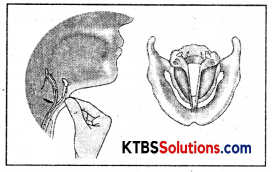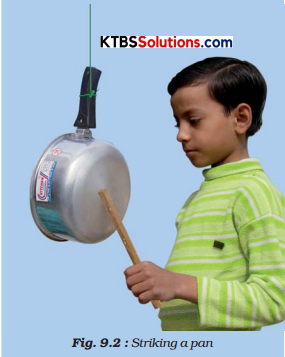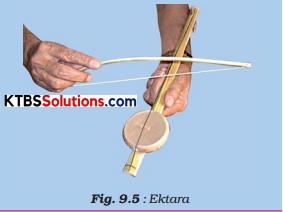You can Download KSEEB Solutions for Class 8 Science Chapter 9 Sound Questions and Answers Pdf, Notes help you to revise the complete syllabus.
KSEEB Solutions for Class 8 Science Chapter 9 Sound
Sound Textbook Questions and Answers
Question 1.
Choose the correct answer:
Sound can travel through
(a) gases only
(c) solids only
(c) liquids only
(d) solids, liquids, and gases.
Answer:
(d) solids, liquids, and gases.
![]()
Question 2.
Voice of which of the following is likely to have a minimum frequency?
(a) Baby girl
(c) Baby boy
(c) A man
(d) A woman
Answer:
(a) Baby girl
Question 3.
In the following statements, tick ‘T’ against those which are true, and ‘F’ against those which are false:
(а) Sound cannot travel in a vacuum. (T/F)
(b) The number of oscillations per second of a vibrating object is called its time period. (T/F)
(c) If the amplitude of vibration is large, the sound is feeble. (T/F)
(d) For human ears, the audible range is 20 Hz to 20,000 Hz. (T/F)
(e) The lower the frequency of vibration, the higher is the pitch. (T/F)
(f) Unwanted or unpleasant sound is termed as music. (T/F)
(g) Noise pollution may cause partial hearing impairment. (T/F)
Answer:
(a) Sound cannot travel in a vacuum. (T)
(b) The number of oscillations per second of a vibrating object is called its time period. (F)
(c) If the amplitude of vibration is large, the sound is feeble. (F)
(d) For human ears, the audible range is 20 Hz to 20,000 Hz. (T)
(e) The lower the frequency of vibration, the higher is the pitch. (F)
(f) Unwanted or unpleasant sound is termed as music. (F)
(g) Noise pollution may cause partial hearing impairment. (T)
![]()
Question 4.
Fill in the blanks with suitable words:
- Time taken by an object to complete one oscillation is called _________
- Loudness is determined by the _________ of vibration.
- The unit of frequency is _________
- Unwanted sound is called _________
- The shrillness of a sound is determined by the _________ of vibration.
Answer:
- Time taken by an object to complete one oscillation is called a time period.
- Loudness is determined by the amplitude of vibration.
- The unit of frequency is hertz.
- An unwanted sound is called noise.
- The shrillness of a sound is determined by the frequency of vibration.
Question 5.
A pendulum oscillates 40 times in 4 seconds. Find its time period and frequency.
Answer:
Time taken by pendulum to complete 40 oscillations = 4 seconds
Time taken by pendulum to complete 1 oscillation = \(\frac{4}{40}\) = \(\frac{1}{10}\) = 0.1 sec.
Time period of pendulum = 0.1 sec.
Frequency of pendulum = \(\frac{\text { oscillation }}{\text { time }}\) = \(\frac{40}{4}\) = 10Hz.
Hence the frequency of the pendulum is 10 Hz.
![]()
Question 6.
The sound from a mosquito is produced when it vibrates its wings at an average rate of 500 vibrations per second. What is the time period of the vibration?
Answer:
For making 500 vibrations time taken is 1 second.
For making 1 vibration time taken is = \(\frac{1}{500}\) second = 0.002 second.
Hence time period of the vibration is 0.002 seconds.
Question 7.
Identify the part which vibrates to produce sound in the following instruments.
(a) Dholak
(b) Sitar
(c) Flute
Answer:
| Instrument | The part which vibrates to produce sound |
| (a) Dholak | Stretched membrane |
| (b) Sitar | Stretched string |
| (c) Flute | Air column |
Question 8.
What is the difference between noise and music? Can music become noise sometimes?
Answer:
Noise: Unpleasant sounds are called noise. Excessive or unwanted sounds lead to noise pollution. Noise pollution may pose health problems for human beings.
Music: Pleasant sound is called music. Music brings about a soothing effect.
Yes, music can become noise sometimes when the musical instruments produce very high volume sounds.
![]()
Question 9.
List sources of noise pollution in your surroundings.
Answer:
Sources of noise pollution in our surroundings are:
- Noise of machines
- Noise of Musical bands
- Sound produced by loudspeakers
- Loud sound of T.V and Radio
- Loud music in parties and marriages
- Noise of crakers
- Loud sounds of domestic electronic appliances such as washing machines, cooler, A.C, mixer grinder, etc.
- The noise of vehicles.
- The honking of horns.
Question 10.
Explain in what way noise pollution is harmful to humans.
Answer:
Noise pollution is harmful to humans because:
- Noise pollution can cause temporary or permanent deafening.
- It can cause many health-related problems like high blood pressure
- It can cause mental illness due to lack of sleep.
![]()
Question 11.
Your parents are going to buy a house. They have been offered one on the roadside and another three lanes away from the roadside. Which house would you suggest your parents should buy? Explain your answer.
Answer:
I would suggest my parents buy the house which is three lanes away from the roadside. This would protect us from noise pollution which is maximum at the roadside building. This would safeguard our health and peace of mind.
Question 12.
Sketch the larynx and explain its function in your own words.

Answer:
The other name of the larynx is the voice box. It is present at the upper end of the windpipe. The function of the larynx is to produce sound.
Question 13.
Lightning and thunder take place in the sky and at the same distance from us. Lightning is seen earlier and thunder is heard later. Can you explain why?
Answer:
The light travels at the speed of 3 × 108 ms-1 which is very large in comparison to the speed of sound which travels at the rate of 330 ms-1 in the air. That is why lightning is seen earlier and thunder is heard later.
![]()
Sound Additional Questions and Answers
Question 1.
Touch the school bell when not in use. what do you feel?
Answer:
There is nothing happening in the bell.
Question 2.
Again touch it (bell) when producing sound. Can you feel it vibrating?
Answer:
Yes, the bell is vibrating this time.
Question 3.
How is the sound produced?
Answer:
Sound is produced by vibrations in objects.
![]()
Question 4.
What is vibration?
Answer:
The to and fro or back and forth motion of an object is called vibration.
Question 5.
Describe the organ in humans that produces sound.
Answer:
In humans, the sound-producing organ is the voice box. It is also called the larynx. In the larynx there are two vocal cords stretched across, leaving a slit for the air to pass through them.

Question 6.
How does the larynx produce sound?
Answer:
The larynx has two vocal cords stretched across it. They are stretched in a way that they leave a slit for the passage of air. When air is pumped in slit by the lung, the vocal cords start vibrating, thus producing the sound.
Question 7.
Does sound need a medium for propagation?
Answer:
Yes, sound needs a medium for propagation.
![]()
Question 8.
Sound travels fastest in which state of matter?
Answer:
Sound travels fastest in solids.
Question 9.
Will the voice come from the telephone you made with paper cups if somebody holds the thread tied in between the cups?
Answer:
The voice will stop coming because vibrations produced by sound in the thread cannot travel further.
Question 10.
What is oscillatory motion?
Answer:
Oscillatory motion is to and fro or back and forth motion of any object.
Question 11.
What is the frequency of oscillation?
Answer:
The number of oscillations per second is called the frequency of oscillation.
![]()
Question 12.
What is the unit of frequency?
Answer:
Hertz (Hz).
Question 13.
What is the range of audible sounds for the human ear?
Answer:
From 20 to 20,000 Hz.
Question 14.
What are the sounds above 20,000 Hz called?
Answer:
Ultrasound.
![]()
Question 15.
How can noise pollution be controlled in a residential area?
Answer:
All noisy operations must be conducted away from any residential area. Noise-producing industries should be set up away from such areas. The use of automobile horns should be minimized.TV and music systems should be run at low volumes. Trees must be planted along the roads and around buildings to cut down on the sounds reaching the residents, thus reducing the harmful effects of noise pollution.
Activities
Activity 1.
Take a metal plate (or a shallow pan). Hang it at a convenient place in such a way that it does not touch any wall. Now strike it with a stick (Fig.). Touch the plate or pan gently with your finger.

Question (i).
Do you feel the vibrations?
Answer:
Yes, we can feel the vibrations.
Question (ii).
Again strike the plate with the stick and hold it tightly with your hands immediately after striking. Do you still hear the sound?
Answer:
No, now we cannot hear the sound.
![]()
Question (iii).
Touch the plate after it stops producing sound. Can you feel the vibrations now?
Answer:
No, now there are no vibrations anymore.
Activity 2.
Take a rubber band. Put it around the longer side of a pencil box (Fig.). Insert two pencils between the box and the stretched rubber. Now, pluck the rubber band somewhere in the middle.

Question (i).
Do you hear any sound? Does the band vibrate?
Answer:
Yes, there is a sound produced on plucking the rubber band. Yes, the band is vibrating.
Activity 3.
Take a metal dish. Pour water in it. Strike it at its edge with a spoon (Fig.)

Question (i).
Do you hear any sound?
Answer:
Yes, very little sound (but not metallic) is produced.
Question (ii).
Again strike the plate and then touch it. Can you feel the dish vibrating?
Answer:
Yes, the dish is vibrating.
![]()
Question (iii).
Strike the dish again. Look at the surface of water. Do you see any waves there?
Answer:
Yes, there is a vibration at the surface of water, and the wave is produced there.
Question (iv).
Now hold the dish. What change do you observe on the surface of the water? Can you explain the change?
Answer:
Now, there is no wave on the surface of water. The waves disappeared because the disturbances produced were stopped by holding the dish.
Question (v).
Is there a hint to connect sound with the vibrations of a body?
Answer:
Yes, the vibrations of a body produce sound.
Activity 4.
Take a hollow coconut shell and make a musical instrument ektara. You can also make it with the help of an earthen pot (Fig.)

Question (i).
Play this instrument and identify its vibrating part.
Answer:
The vibrating part of the instrument is stretched string.
![]()
Activity 5.
Take a metal glass tumbler. Make sure that it is dry. Place a cell phone in it. (Remember that the cell phone must not be kept in water) Ask your friend to give a ring on this cell phone from another cell phone. Listen to the ring carefully.
Now, surround the rim of the tumbler with your hands (Fig.). Put your mouth on the opening between your hands. Indicate to your friend to give a ring again. Listen to the ring while sucking air from the tumbler.

Question (i).
Does the sound become fainter as you suck air?
Answer:
Yes, the sound becomes fainter as we suck air.
Question (ii).
Remove the tumbler from your mouth. Does the sound become loud again?
Answer:
Yes, the sound becomes loud again.
![]()
Question (iii).
Can you think of an explanation? Is it possible that the decreasing amount of air in the tumbler had something to do with decreasing loudness of the ring?
Answer:
This happened because sound needs a medium to travel. Indeed, if you had been able to suck all the air in the tumbler, the sound would stop completely. When the air has been removed completely from a vessel, it is said that there is a vacuum in the vessel. The sound cannot travel through a vacuum.
Activity 6.
Take a bucket or a bathtub. Fill it with clean water. Take a small bell in one hand. Shake this bell inside the water to produce sound. Make sure that the bell does not touch the body of the bucket or the tub. Place your ear gently on the water surface (Fig.).

Question (i).
Can you hear the sound of the bell? Does it indicate that sound can travel through liquids?
Answer:
Yes, I can hear the sound of the bell. Yes, this activity indicates that sound can travel through liquids.
Activity 7.
Take a meter scale or a long metal rod and hold one end to your ear. Ask your friend to gently scratch or tap at the other end of the scale (Fig.).

Question (i).
Can you hear the sound of the scratching? Ask your friends around you if they were able to hear the same sound?
Answer:
Yes, I can hear the sound of the scratching. My friends around me were not able to hear the same sound.
![]()
Activity 8.
Take a plastic or tin can. Cut its ends. Stretch a piece of rubber balloon across one end of the can and fasten it with a rubber band. Put four or five grains of dry cereal on the stretched rubber. Now ask your friend to speak “Hurrey, Hurrey” from the open end (Fig.).

Question (i).
Observe what happens to the grain. Why do the grains jump up and down?
Answer:
The grains jump on the stretched rubber up and down repeatedly. The grains jump up and down because of the vibration caused underneath the stretched rubber.
Activity 9.
Take a metallic tumbler and a tablespoon. Strike the tablespoon gently at the rim of the tumbler. Hear the sound produced. Now bang the spoon on the tumbler and hear the sound produced again.

Question (i).
Is the sound louder when the tumbler is struck hard?
Answer:
Yes, the sound is louder, when the tumbler is struck hard. Now suspend a small thermocole ball touching the rim of the tumbler (Fig.). Vibrate the tumbler by striking it. See how far the ball is displaced. The displacement of the ball is a measure of the amplitude of vibration of the tumbler.
![]()
Question (ii).
Now, strike the tumbler gently and then with some force. Compare the amplitudes of vibrations of the tumbler in the two cases. In which case is the amplitude larger?
Answer:
The amplitude of the sound is larger in the first case.